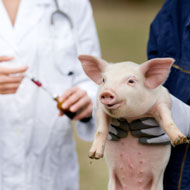Antimicrobial use in animals ‘should be reduced’

RUMA chair Gwyn Jones said it was positive that EMA and EFSA recognised there is no ‘one size fits all approach’.
EU agencies have said the use of antimicrobials in animals should be reduced and replaced where possible, and new farming systems introduced to prevent infectious diseases.
In a joint statement, the European Medicines Agency (EMA) and European Food Safety Authority (EFSA) said the use of antimicrobials in food-producing animals should be reduced to the minimum amount needed to treat infectious diseases.
Experts concluded that, apart from in exceptional cases, preventative use of antimicrobials should be phased out in favour of alternative measures, and antibiotics that are critically important for human medicine should only be used in animals as a last resort.
EFSA’s executive director Dr Bernhard Url commented: “It is clear that strategies that are already available can be implemented immediately and will have a positive impact on levels of antimicrobial resistance. At the same time, there is a need for innovative solutions – we need to find alternative ways to prevent and treat bacterial infections in animals.”
Alternatives to antimicrobials that have been shown to improve animal health include vaccines, probiotics, prebiotics, bacteriophages and organic acids.
However, EMA and EFSA stressed that reducing the use of antimicrobials and finding alternatives is not enough. Livestock systems need to be rethought, and farming practices implemented to prevent the introduction and spread of disease on farms.
The conclusions were welcomed by RUMA, which promotes responsible use of medicines in farming. RUMA chair Gwyn Jones said it was positive that EMA and EFSA recognised there is no ‘one size fits all approach’ and different situations require different approaches.
“There has been a tendency for critics to promote alternative farming systems or demand blanket implementation of rules in other countries, when that we actually need is to reduce use in a sustainable way that safeguards animal welfare.”
Mr Jones added that the UK is already well on the way to meeting its target to reduce antibiotic use by nearly a fifth by 2018. Poultry meat companies stopped prophylactic use of all antibiotics in 2016 by working with the British Poultry Council, although RUMA says it recognises that preventative treatment will be needed temporarily while the vet and farmer make improvements to biosecurity and husbandry.
Use of critically important antibiotics has also been voluntarily restricted by the poultry, pig and now cattle sectors.



 The RCVS has announced a new version of its 1CPD mobile app, with enhanced features for veterinary surgeons and veterinary nurses to record their continuing professional development.
The RCVS has announced a new version of its 1CPD mobile app, with enhanced features for veterinary surgeons and veterinary nurses to record their continuing professional development.